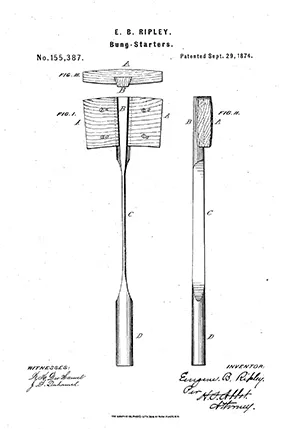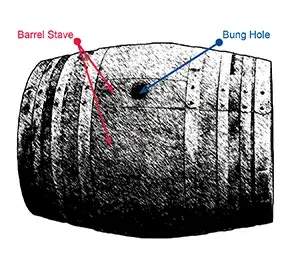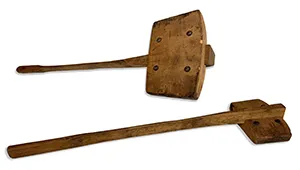
1874, for “Improvement in Bung-Starters.”
Several bungstarts in the CBP Historical
Collections are based on this design, featuring
the head attached to the handle with a tapering
dovetail connection, and 4 screws or rivets
(shown as “a” in the patent illustration) intended
to strengthen the head and prevent splitting.
Among the arsenal of tools used by certain Customs Appraisers was a strange-looking mallet. Its long wooden handle tapered to a thin strip, attached to a flattened wooden head by a dovetail joint and/or rivets, bolts or dowels. The design—a heavy head on a delicate handle—makes it seem fragile and not suitable for pounding; indeed, some of the examples in the CBP Historical Collections have been repaired with glue, wire and string.
But the shape and construction of the mallet is intentional. The thin handle creates flexibility, so that when the bungstart mallet (a.k.a. bung starter) strikes a barrel stave, it causes a vibration that loosens the seal on the bung (stopper or plug), making it easy to pop it out of the bung hole. This is the bung starter tool’s only function. Once the barrel was opened, the Customs team then used a variety of gauges and equipment to measure and test the contents to determine the correct tariff.
Wooden barrels (and its sisters of various sizes, such as tuns, hogsheads, kegs and firkins) with bung holes were used for transporting liquids from the early days of our nation into the 1950’s, when they were largely replaced by an assortment of containers. Though commodities such as olives and pickles are now primarily in glass jars, wood barrels are still used in the production and storage—and occasional shipment—of alcohol-based beverages like wine, whiskey, bourbon and sake.

and bung hole.

Object ID# 2015.2.12
Wood handle and head, with steel rivets through the head.
A damaged split handle was repaired with a copper wire wrap.
Dimensions: 24.5” x 6”
Transferred from the Port of Minneapolis, Minnesota.

Object ID# 2015.2.11
Wood handle and head, with steel rivets through the head.
“US Customs” is handwritten in three locations along the handle.
Dimensions: 24.5” x 6”
Transferred from the Port of Minneapolis, Minnesota.

